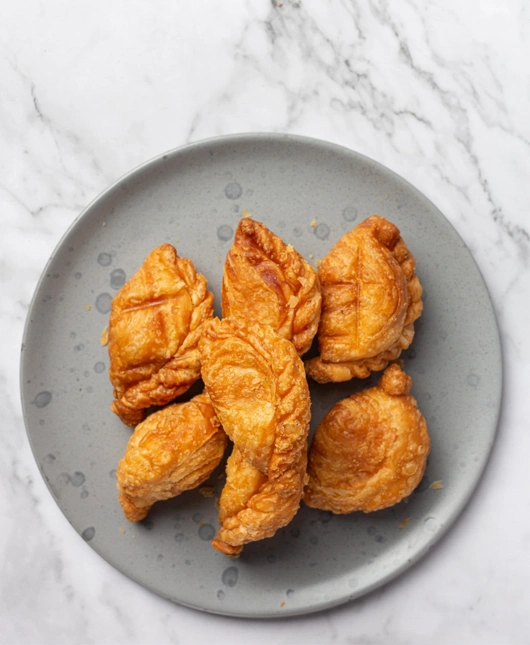

Top Health Benefits of Fried Curry Puff You Need to Know
Curry puffs are a delightful treat, offering a combination of carbohydrates, proteins, and fats that make them a fulfilling snack or meal. The flaky pastry is primarily made from refined flour, providing a good source of carbohydrates for energy. The filling, typically composed of mashed potatoes, ground meat (such as chicken or beef), onions, and spices, contributes to the dish’s protein and fiber content. The potatoes provide a healthy dose of vitamins and minerals, such as vitamin C, potassium, and vitamin B6, while the meat adds essential protein and iron. The spices, particularly curry powder, are known for their antioxidant and anti-inflammatory properties, offering potential health benefits such as improved digestion and immune support. However, as the curry puffs are deep-fried, they contain a significant amount of fats, which should be consumed in moderation, especially for those managing their fat intake. By using lean meats and reducing the amount of oil, the dish’s overall nutritional profile can be improved, making it a more balanced option for various dietary needs.
Recipe :
For 4 people (about 12 Curry Puffs)
Enjoy your delicious homemade Curry Puffs!
When preparing curry puffs, there are several important tips to ensure both the flavor and texture are spot-on. First, be mindful of the dough – it should be well kneaded and rested before rolling out to ensure a flaky, crisp pastry once fried. Allow the dough to chill for at least 30 minutes in the refrigerator to help it firm up and become easier to handle. For the filling, make sure to cook the vegetables and meat thoroughly to avoid any raw tastes. Season the filling generously, but don’t overdo the salt, as the dough itself may already have a salty flavor. It’s also important to ensure the filling has cooled completely before using it to avoid soggy dough. When assembling the curry puffs, be sure to seal the edges tightly to prevent the filling from spilling out during frying. The frying oil should be hot enough to cook the curry puffs evenly and create that golden-brown, crispy exterior. Lastly, be cautious when frying to prevent burning and ensure the puffs are cooked through. After frying, place them on a paper towel to absorb excess oil before serving.

Curry puffs, while delicious, may not be suitable for all dietary regimes due to their ingredients and cooking methods. For those following a Ketogenic diet, the high carbohydrate content from the pastry and potatoes makes curry puffs unsuitable. Similarly, individuals on a Paleo diet may want to avoid them because of the refined flour in the pastry, which is not allowed on this diet. Those adhering to a Vegan diet should also avoid traditional curry puffs as they typically contain meat and butter, though a vegan version can be made by replacing these ingredients with plant-based alternatives like tofu and coconut oil. For those on a Gluten-Free diet, curry puffs made with regular wheat flour are not recommended, but a gluten-free flour substitute can be used to create a suitable version. On the other hand, curry puffs can fit well into a Vegetarian diet, assuming the filling consists of plant-based ingredients or vegetarian protein sources. For people seeking low-calorie options, curry puffs may not be the best choice due to the deep frying and use of butter, but modifying the recipe to bake instead of fry, and using lighter fillings, can make them more suitable. Individuals following a High Protein diet can benefit from the protein content in the meat and the optional addition of legumes or tofu for added protein. Additionally, for those on the DASH diet, which focuses on controlling sodium intake, the curry puffs might need modification to reduce salt and oil content. Ultimately, while curry puffs are a delicious treat, they should be consumed in moderation depending on your dietary preferences and goals.
...